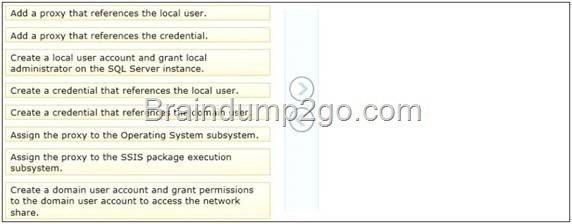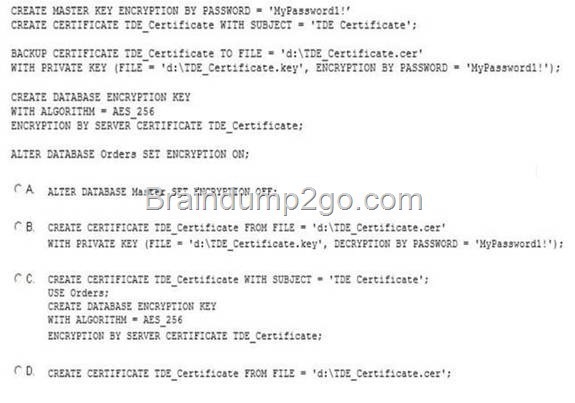QUESTION 51
Drag and Drop Question
You administer a Microsoft SQL Server database. Service accounts for SQL Agent are configured to use a local user. A Microsoft SQL Server Integration Services (SSIS) job step has been created within a SQL Server Agent job. The SSIS package accesses a network share when exporting data from a SQL Server database. When you execute the SQL Server Agent job, it fails due to a permissions failure on a share on a remote server. You need to ensure that the SQL Server Agent job can execute the SSIS package. Which four actions should you perform in sequence? (To answer, move the appropriate actions from the list of actions to the answer area and arrange them in the correct order.)

Answer:
![clip_image0024_thumb_thumb_thumb_thu[2]_thumb_thumb clip_image0024_thumb_thumb_thumb_thu[2]_thumb_thumb](http://examgod.com/l2pimages/dc5df07f97c2_A40A/clip_image0024_thumb_thumb_thumb_thu2_thumb_thumb_thumb.jpg)
QUESTION 52
You administer a Microsoft SQL Server 2012 instance. You need to configure a new database to support FILETABLES. What should you do? Choose all that apply.
A. Disable FILESTREAM on the Database.
B. Enable FILESTREAM on the Server Instance.
C. Configure the Database for Partial Containment.
D. Create a non-empty FILESTREAM file group.
E. Enable Contained Databases on the Server Instance.
F. Set the FILESTREAM directory name on the Database.
Answer: BDF
Explanation:
http://msdn.microsoft.com/en-us/library/gg509097.aspx
QUESTION 53
You administer two instances of Microsoft SQL Server 2012. You deploy an application that uses a database on the named instance. The application is unable to connect to the database on the named instance. You need to ensure that the application can connect to the named instance. What should you do?
A. Configure the application as data-tiered.
B. Open port 1433 on the Windows firewall on the server.
C. Configure the named SQL Server instance to use an account that is a member of the Domain Admins group.
D. Start the SQL Server Browser Service.
Answer: D
QUESTION 54
You administer a Microsoft SQL Server 2012 database. You configure Transparent Data Encryption (TDE) on the Orders database by using the following statements:
You attempt to restore the Orders database and the restore fails. You copy the encryption file to the original location. A hardware failure occurs and so a new server must be installed and configured. After installing SQL Server to the new server, you restore the Orders database and copy the encryption files to their original location. However, you are unable to access the database. You need to be able to restore the database. Which Transact-SQL statement should you use before attempting the restore?

A. Option A
B. Option B
C. Option C
D. Option D
Answer: B
QUESTION 55
You have configured Resource Governor with three resource pools. You have assigned the first resource pool a minimum CPU and memory value of 20%. You have assigned the second resource pool a minimum CPU and memory value of 30%. You want to assign maximum CPU and memory values to the third resource pool. What is the maximum CPU and memory value you can assign to this resource pool?
A. 30%
B. 50%
C. 70%
D. 100%
Answer: B
QUESTION 56
You administer a SQL Server 2012 server that contains a database named SalesDb. SalesDb contains a schema named Customers that has a table named Regions. A user named UserA is a member of a role named Sales. UserA is granted the Select permission on the Regions table. The Sales role is granted the Select permission on the Customers schema. You need to ensure that the Sales role, including UserA, is disallowed to select from any of the tables in the Customers schema. Which Transact-SQL statement should you use?
A. REVOKE SELECT ON Schema::Customers FROM UserA
B. DENY SELECT ON Object::Regions FROM UserA
C. EXEC sp_addrolemember ‘Sales’, ‘UserA’
D. DENY SELECT ON Object::Regions FROM Sales
E. REVOKE SELECT ON Object::Regions FROM UserA
F. DENY SELECT ON Schema::Customers FROM Sales
G. DENY SELECT ON Schema::Customers FROM UserA
H. EXEC sp_droproleraember ‘Sales’, ‘UserA’
I. REVOKE SELECT ON Object::Regions FROM Sales
J. REVOKE SELECT ON Schema::Customers FROM Sales
Answer: F
Explanation:
References:
http://msdn.microsoft.com/en-us/library/ms188369.aspx
http://msdn.microsoft.com/en-us/library/ms187750.aspx
http://msdn.microsoft.com/en-us/library/ff848791.aspx
QUESTION 57
You administer a SQL Server 2012 server that contains a database named SalesDb. SalesDb contains a schema named Customers that has a table named Regions. A user named UserA is a member of a role named Sales. UserA is granted the Select permission on the Regions table. The Sales role is granted the Select permission on the Customers schema. You need to ensure that UserA is disallowed to select from any of the tables in the Customers schema. Which Transact-SQL statement should you use?
A. DENY SELECT ON Object::Regions FROM UserA
B. DENY SELECT ON Object::Regions FROM Sales
C. REVOKE SELECT ON Schema::Customers FROM Sales
D. REVOKE SELECT ON Schema::Customers FROM UserA
E. REVOKE SELECT ON Object::Regions FROM Sales
F. REVOKE SELECT ON Object::Regions FROM UserA
G. DENY SELECT ON Schema::Customers FROM Sales
H. DENY SELECT ON Schema::Customers FROM UserA
I. EXEC sp_addrolemember ‘Sales’, ‘UserA’
J. EXEC sp droprolemember ‘Sales’, ‘UserA’
Answer: H
Explanation:
http://msdn.microsoft.com/en-us/library/ms188369.aspx
http://msdn.microsoft.com/en-us/library/ms187750.aspx
http://msdn.microsoft.com/en-us/library/ff848791.aspx
QUESTION 58
You administer a SQL 2012 server that contains a database named SalesDb. SalesDb contains a schema named Customers that has a table named Regions. A user named UserA is a member of a role named Sales. UserA is granted the Select permission on the Regions table. The Sales role is granted the Select permission on the Customers schema. You need to remove the Select permission for UserA on the Regions table. You also need to ensure that UserA can still access all the tables in the Customers schema, including the Regions table, through the Sales role permissions. Which Transact-SQL statement should you use?
A. DENY SELECT ON Object::Regions FROM UserA
B. DENY SELECT ON Schema::Customers FROM UserA
C. EXEC sp_addrolemember ‘Sales’, ‘UserA’
D. REVOKE SELECT ON Object:: Regions FROM UserA
E. REVOKE SELECT ON Object::Regions FROM Sales
F. EXEC sp_droproiemember ‘Sales’, ‘DserA’
G. REVOKE SELECT ON Schema::Customers FROM UserA
H. DENY SELECT ON Object::Regions FROM Sales
I. DENY SELECT ON Schema:: Customers FROM Sales
J. REVOKE SELECT ON Schema:: Customers FROM Sales
Answer: D
Explanation:
http://msdn.microsoft.com/en-us/library/ms188369.aspx
http://msdn.microsoft.com/en-us/library/ms187750.aspx
http://msdn.microsoft.com/en-us/library/ff848791.aspx
QUESTION 59
You administer a SQL Server 2012 server that contains a database named SalesDb. SalesDb contains a schema named Customers that has a table named Regions. A user named UserA is a member of a role named Sales. UserA is granted the Select permission on the Regions table and the Sales role is granted the Select permission on the Customers schema. You need to ensure that the Sales role, including UserA, is disallowed to select from the Regions table. Which Transact-SQL statement should you use?
A. REVOKE SELECT OK Schema::Customers FROM UserA
B. REVOKE SELECT ON Object::Regions FROM UserA
C. EXEC sp_addrolemember ‘Sales’, ‘UserA’
D. DENY SELECT ON Schema::Customers FROM Sales
E. EXEC sp_droprolemember ‘Sales’, ‘UserA’
F. REVOKE SELECT ON Schema::Customers FROM Sales
G. DENY SELECT ON Object::Regions FROM UserA
H. REVOKE SELECT ON Object::Regions FROM Sales
I. DENY SELECT ON Schema::Customers FROM UserA
J. DENY SELECT ON Object::Regions FROM Sales
Answer: J
Explanation:
http://msdn.microsoft.com/en-us/library/ms188369.aspx
http://msdn.microsoft.com/en-us/library/ms187750.aspx
http://msdn.microsoft.com/en-us/library/ff848791.aspx
QUESTION 60
You administer a single server that contains a Microsoft SQL Server 2012 default instance on which several production databases have been deployed. You plan to install a new ticketing application that requires the deployment of a database on the server. The SQL login for this application requires sysadmin permissions. You need to ensure that the login for the ticketing application cannot access other production databases. What should you do?
A. Use the SQL Server default instance and enable Contained Databases.
B. Use the SQL Server default instance and configure a user-defined server role.
Add the login for the ticketing application to this role.
C. Install a new named SQL Server instance on the server.
D. Install a new default SQL Server instance on the server.
Answer: C
Download Free Braindump2go New Updated Microsoft 70-462 Dumps Full Version, In PDF Format, 189 Questions and Answers in all: http://www.braindump2go.com/70-462.html